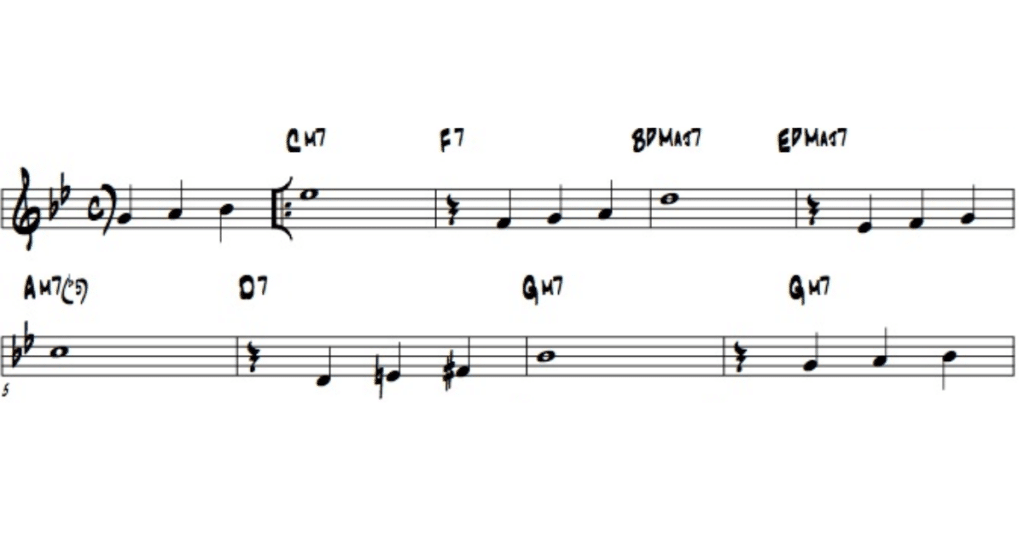Want to learn how to play a piano fake book? Look no further, sheet music has long been a way of standardizing the written expression of music. Writing a song by using symbols such as black, white and round, allows you to communicate a piece’s performance regardless of cultural traits, such as language or nationality, giving these symbols a universal character. However, that conventionality of the musical language can be altered often, and scores with American ciphers are examples. This is how the “Fake Book” or as a Lead Sheet was born.
You’ve likely come across some hot selling piano books described as a “Fake Book” as you’ve browsed the web for sheet music. Here are probably a few examples you’ve come across:
- The New Broadway Fake Book
- The Ultimate Fake Book (for C Instruments) by Hal Leonard Corp
- Your First Fake Book: Featuring Large Music Notation, Lyrics, & Simplified Harmonies C Edition
- The Ultimate Rock Pop Fake Book by Hal Leonard Corp
What is a Piano Fake Book?
The American cipher is a musical notation brought from the English culture that defines the chords with letters and symbols. It is what makes the basis of a piano fake book. It is characterized by being a simple way to communicate extensive and complex musical forms, allowing a wide range of possibilities for musicians to express their ideas concisely and understandably. Instead of writing chords in a pentagrammed notebook, pointing out the accidentals (sharps and flats), and taking care of the excellent detail of the traditional musical notation, they are expressed by short combinations of letters and symbols previously defined.
For example, using capital letters to indicate musical notes:
In turn, if necessary, a fake book can add other letters and symbols to such notes to indicate that they are major, minor, dominant, diminished, augmented, etc. chords. (see American encoding)
Piano Fake Book Sheet Music
Lead sheet music is a direct representation of the idea that the composer or arranger wanted to express. It’s the concept of integrating melody, harmony, and rhythm in a very concise and understandable way for anyone who has previous music theory knowledge. The only way to accurately interpret a piece of music, expressing the author’s feelings, is to follow in detail the instructions that the scores represent. Because, in effect, seeing sheet music as a set of instructions that, when followed correctly, can result in an admirable musical performance.
But what if those instructions were not detailed or were replaced by shorter, simpler sentences? In this case, several musical skills would have to be put into practice and integrated to achieve the desired interpretation. This is the case of scores written with the help of the piano fake book notations. In the following image, you can see how they would look like.

You can see the remarkable simplicity that the score acquires when written with the American cipher’s help. Thus, to be understood, you must identify the two main points in it:
- The melodic line: written with the traditional use of musical symbols on the staff, such as quarter notes, half notes, and round notes.
- The chord progression: commonly written on the staff and using the notation defined by the piano fake book notation.
Other details, such as rhythm, bass, and the integration of melody and harmony often depend on the performing musician’s skill and the song itself.
Score with American Piano Cipher
When we think of sheet music for the piano, the first thing that comes to mind is a double notation in the pentagram notebook, one for the treble clef and the other for the bass clef. That is, the traditional notation illustrates in detail what the left hand and right hand do when playing a piece on the piano (see piano sheet music).
However, the scores with American piano notation do not detail what each hand does. The musician could decide to play the melody with the left hand and the chords with the right hand, vice versa, and perform the song grandly. But, as such scores do not wholly specify what the author wants to express, the final song can take several paths, even under the interpreting musician’s improvisation.
So, when a musician comes across sheet music written as a lead sheet or fake book, he should see it only as a reference to the original song. The only way to accurately interpret the original song will be by listening to it beforehand and complementing the learning by listening to the reference scores. However, this does not seem to be the main reason for this type of score since traditional notation already does the job. On the other hand, scores written with the American cipher give the musician more freedom to interpret the piece since it only indicates the most important and, at the same time, the most general aspects.
How to play the lead sheet (fake book) scores on the piano?
Indeed, there is not only one way to play this kind of score, and even less in an instrument as versatile as the piano. So, because illustrating the melodic line with the chords above it, you could think of playing them simultaneously. It would be an excellent way to begin an interpretation of this type of score. However, it is at this point that the skill of music theory and the practice of the instrument are necessary to add (or subtract) expressiveness to the song. This is done with the help of scales, bass handling, chromaticisms, modes, polyrhythms, etc. Use the following tips as a basis for this:
Basic tips for interpreting a Fake Book
- When faced with sheet music, it is important to identify the key in which the song is written, no matter what kind it is. You can find the key by looking at the accidentals (sharps and flats) present in the key signature (see key signatures).
- Once the song’s key is found, identify all the keys on the piano that correspond to notes belonging to that key. Thus, the melodic line and the chords indicated in the score must fall on the keys identified. Otherwise, the notes used may be chromaticisms used by the author for the development of the song. You can omit this step if you have previous piano experience.
- The melodic line is played slowly with the right hand, respecting the tempo of the song. This process can be repeated as many times as necessary until you are familiar with the melody.
- In the song, chords are identified and played in rounds, practicing the change of position between each chord with the left hand.

- After practicing each hand individually, play the melody and harmony simultaneously. In this step, it is impossible to know how long to wait to make the left hand chord change. This union between melody and harmony is visually identified in the score. That is, chords usually placed above the note on which they start playing and, in turn, that note usually coincides with a strong beat of the bar (see strong and weak beats).
Tips for the experienced musician
If you follow the above tips, you can get a simple version of the song, playing a melodic line while certain chords are changing. However, when you turn on the radio or play a record the reality is different. Many songs are written using American cipher scores without losing complexity, expressiveness, and feeling when performed. Therefore, you can follow the following tips to enrich the interpretation of the piece:
- Instead of continuously playing the chords for the whole bar or until the next bar comes along, it is convenient to use arpeggios. The arpeggios can have a secondary melodic line role, making the piece dynamic. These will consist of playing successive combinations of the notes that make up each chord. So, for example, if we have to play the E minor chord (Em), which is made up of the notes E, B, and G, we can play those notes one after the other repeatedly instead of all three at the same time.
- If the chords are placed in each bar’s strong beats, it is convenient to play the tonic (main note) of the chords strongly. This imitates the role of the bass and the song gains consistency. Also, if you have previous bass experience, you can add arpeggios in the piano’s lower octaves.
- A second line can be added to the melodic line to be played simultaneously with the original one. This can be achieved by playing along with each note the third, fifth, or octave of that note (see musical intervals).
- If the melodic line is repeated in certain measures, the octaves in which it is played with the right hand can be varied. For example, if you played in a certain octave of the piano in a first repetition, in the next repetition, you can play an octave higher.
So, following all these tips will serve as a basis for the musician to understand a score with American cipher and proceed to play it. However, the success of such an interpretation lies in study, practice and improvisation, all guided by creativity.
The above tips do not represent the only way to play the piano based on a score with an American cipher in the same vein. The musician could play the chords with the right hand and the melodic line with the left hand without losing the song’s sense. Likewise, you can find a lot of combinations to make the arpeggios. All these aspects depend on the musician’s intention, the type of song being played and the sheet music itself.
How to use a Fake Book - Featuring 100 Left Hand Patterns Every Piano Player Should Know
How the Piano Fake Book Got Started
The use of the Fake Book sheet music originated with jazz musicians, in particular the jazz piano. Jazz is a musical genre characterized by its complex chord progressions, elaborate melodic lines, and improvisational nature. Thus, due to the extensive instrumentation and structure of the genre, jazz performers had to devise a more practical way of making musical notations with simplified chords that they could easily alter. This left a large task of memorizing the rest of the arrangements excluded from their scores, giving rise to the famous ability to improvise that many musicians of the genre manifested.

The lead sheet legacy has transcended through the years and has adapted to convenience and necessity. More and more musicians are turning to the use of these scores to complement their musical studies and everyday use of musical notation.
Advantages and disadvantages
As we have already seen, there is no absolute parameter for using scores and their application on instruments. Each musician can find in the tools they use that best suits their needs. However, it is possible to point out certain advantages of American notation scores over traditional scores:
- They facilitate the communication of ideas between musical groups because it allows interpretation regardless of the instrument played.
- It is more practical when writing several versions of the same song in different keys.
- It helps to identify those chords that you can use in conjunction with the melody.
- It gives freedom to the musician to develop an improvisation based on the melodic line.
- Its simplicity allows adding some modification directly on the chords or the melodic line.
Conclusion
Using piano fake book sheet music is a versatile tool that does not require much music knowledge to understand, useful for beginning your music theory studies. Simultaneously, the piano is a beneficial instrument for interpreting this kind of score and even facilitates improvisation due to its visual character compared to other instruments. Every musician who wishes to expand his theoretical and practical skills should practice reading traditional sheet music and writing songs, his own or not, using a fake book.





